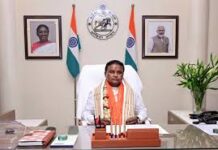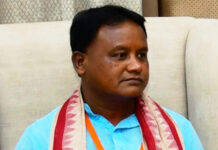“Eat and drink as much as you like and enjoy this rare celestial event”, Professor M N Vahia, Dean School of Mathematical Sciences, NMIMS said busting all the myths behind eclipses observed in India.
He was addressing Enchanting Eclipses – Science, Myth and Culture lecture organised by Nehru Science Centre, M/o Culture ahead of the eagerly awaited first Solar eclipse of 2020 to occur on 21st June.
According to Prof. Vahia, there is no religious text that claims that eclipses are dangerous. They are mere superstitions created by people who are scared of the eclipses. “On the contrary we can even see how eclipses have been beautifully discussed in ancient literature”, he added. “No scriptures recommend hiding away during its occurrence. One should have more faith and understanding about the working of the universes and not be carried away by superstitions”.
We are not that important.
Unlike the common belief, the sun does not send any special radiation during the eclipse. Even though we call it a Solar Eclipse, the sun is completely unaware of its occurrence. The sun is too big to be bothered about where the moon’s shadow falls. “We are exaggerating our own sense of importance in the universe. Eclipse is a small drama and to the Universe it is an irrelevant phenomenon,” he said rejecting the false claims about impacts of eclipses on human life.
He also mentioned that we do not get to see many eclipses in our lifetime and hence one should not miss this rare opportunity that occurs every 18 years. We should not waste it by hiding in the house and staying hungry fearing myths being imposed on us.
“Eclipses are fantastic to see but it is not worth losing your eyes”, he cautioned about seeing the eclipse with naked eyes. The safest way of looking at the eclipse is through a pinhole cardboard by getting it projected it on the screen.
Myths!
Eclipses have been a source of anxiety for people everywhere and have even scared them. It may be common to feel anxious when you first observe an eclipse tomorrow, to see the sun disappear and that too not because of clouds.
What did Eclipse mean to different cultures?
Most cultures viewed it as a period during which the sun or the moon is being attacked by an animal or a demon.
Vikings, Koreans, Vietnamese, Chinese and many others imagined an animal eating the sun and excreting the sun from the other end. They used to think that there is a great animal in the sky. To threaten the animal, people even pelted stones at animals on earth, made noises, used drums to scare the demons run away.
Eskimos turned their utensils upside down to prevent bad influences from falling into their cooking. West Africans gathered in open spaces to urge the shadow to leave the sun.
American Indians thought the sun lost some of its power and hence sent burning arrows in the direction of the sun to rekindle it.
In Egypt, the King, a representative of the Sun made rounds of the city to assure people. Babylonians, Greeks, Romans considered it an omen and the month of eclipse was considered important. Armenians thought the sun was invaded by a black planet.
Japanese lit fires and displayed shiny jewels to compensate for the dulling of the sun.
A few, like Maoris of Assam considered eclipse as a good omen, means an imminent victory over their enemies, while most people around the world believed it a bad omen.
There are also evidences that at around 585 BC, an eclipse predicted earlier, occurred during a war between the Medians and the Lydians. They called off the war and declared peace.
Indian myths:
In Mahabharata’s Kurukshetra war, there are references of two eclipses Solar and Lunar that occurred within a gap of 13 days between each other – solar followed by lunar. One may find it unique but the fact is not. There are evidences that such event occurs every 800 years i.e Solar and Lunar eclipse succeeding each other within days.
Kolam tribes of India consider solar eclipse is the time when debt collectors come to collect the debts from the sun. The debt collector insists the Sun to pay off the debts since too many sins have occurred on earth. If the sun is completely covered, they feel happy, because the total solar eclipse means the debts have been completely paid off. If the eclipse covers only the top part of the sun then it is a bad omen for humans and if it covers only bottom part of the sun then it is bad sign for animals because their part of debt is not paid for.
Korku Tribe in Central India also thinks the eclipse occurs when the human sins overflow. There is a unique practice where they take a shaft used for grinding food, and place it vertically in a plate with water. As long as the eclipse is on, the rod remains vertical on its own, they say.
Later, eclipses have been used by people to collect donations to help the gods to fight the demons. There are records of huge donations made by rich people in earlier days which are actually a blessing to track the occurrence of eclipses centuries ago. These have been carved in stones, temple pillars, etc as records.
The oldest record of eclipse comes in Rig Veda. It describes how great Sage Arti saved the Sun from the Svarbhanu who tried to destroy him.
The notable change in colour of the solar disc during the entire process of the eclipse has been beautifully described in a passage in the Pancavimsa-Brahmana. It explains as Arti repelled its darkness, first the sun became a black sheep, then a silvery sheep, then a reddish one and with the arrow with which he set free its original appearance that was a white sheep.
This is nothing but the notable feature is the change in colour of the eclipse. One will find this pattern while witnessing the eclipse – first black, and since our eyes get used to the dullness it will start appearing silvery and bright, and as our eyes get set it appears reddish and eventually it regains its original colour.
Conventional Indian Myths:
The occurrence of eclipse is mentioned in Samudra Manthan – the churning of ocean by the Gods and the asuras. It occurred when the Gods and the Asuras wanted to be immortal by consuming nectar that is available under the sea, the sea had to be churned. Since neither of them had the power they came together to churn the sea.
However, when the nectar finally comes out the gods cheat, by sending a beautiful woman Mohini to distract the Asuras. Mohini distributes the Amrit among the gods, but one Asura, Rahu realises the trickery joins the gods and drinks the nectar. But before he consumed it, the sun and the moon realised and cut his head. As it was not quick enough – the head and body of the Rahu survived. Now people believe that forever revengeful Rahu tries to eat them up but since he is disembodied it comes through the other end as he gulps them down on eclipses.
It was in 499 AD Aryabhata realised that eclipse is all shadow and that there are no demons involved. He reinvented the idea that Rahu and Ketu are just points in the sky and hence they are two dark planets that cause eclipse.
Varahamihira converted Rahu and Ketu from mere myths to celestial bodies thus making it dark points in the sky. They are no more Asuras and are being worshipped as Navagrahas.
Studies show that the Earth, which used to take 400 days to complete rotation, has been slowed down by eclipses. Ancient record of eclipse helps to know about the movement of the sun, rotation of the earth and how it is slowing down over years and its impact.
Eclipses have always fascinated people from an earlier period. It may be just the shadow of the moon on earth but it is a remarkable experience to witness it.
“Eclipses are one of the spectacular events you can witness in your life time and therefore don’t miss the opportunity due to superstitions”












































